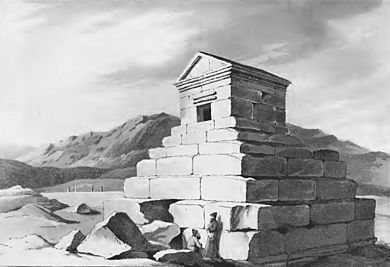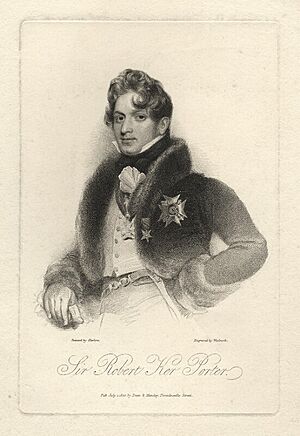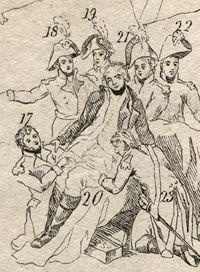Robert Ker Porter facts for kids
Sir Robert Ker Porter (1777–1842) was a Scottish artist, writer, diplomat, and traveler. He is known today for his exciting stories about his journeys in Russia, Spain, and Persia. He was one of the first artists in Britain to paint huge panorama scenes. He even became a special historical painter for Tsar Alexander I of Russia. Later, he worked as a British consul in Venezuela, which is like being a country's representative in another land.
Contents
Early Life and Art Dreams
Robert Ker Porter was born in Durham, England, in 1777. He was one of five children. His father, William Porter, was an army surgeon. Robert's sisters, Jane Porter and Anna Maria Porter, grew up to be famous writers.
When Robert was very young, his father passed away. His mother then moved the family to Edinburgh. Robert went to Durham School. He decided he wanted to paint big battle scenes. In 1790, his mother took him to meet a famous painter named Benjamin West. Mr. West was so impressed with Robert's drawings that he helped him get into the Royal Academy to study art.
Robert quickly showed his talent. In 1792, he won an award for a drawing called The Witch of Endor. He also painted religious scenes for churches. These included Christ allaying the Storm in 1794 and St. John Preaching in 1798.
Amazing Panorama Paintings
In 1800, Robert started working as a scene-painter at the Lyceum Theatre. That same year, he created a huge painting called Storming of Seringapatam. This painting was 120 feet (37 m) long and wrapped around in a big circle! It was a sensation when it was shown at the Lyceum. His sister Jane said he painted it in just six weeks.
He made other successful panorama paintings too. These included the Battle of Lodi (1803) and the Defeat of the French at the Devil's Bridge (1804). He also showed many paintings at the Royal Academy. Some of these were Death of Sir Philip Sydney (1792) and The Defeat of King Stephen at the Battle of Lincoln (1793).
Exciting Travels and Discoveries
In 1804, Robert was asked to be the historical painter for Tsar Alexander I of Russia. He moved to St Petersburg and painted large historical scenes for the Admiralty Hall. While there, he fell in love with a Russian princess named Mary.
Because of some difficulties with their relationship, he left Russia for a while. He traveled through Finland and Sweden. In 1806, King Gustav IV Adolf of Sweden made him a knight. He then visited several German royal courts. In 1807, he received another knighthood, this time from the Order of St Joachim.
While in Sweden, Robert met General Sir John Moore. He joined the general on a military trip to Spain. Robert was there for the whole journey, including the Battle of Coruña. He made many sketches of the campaign.
His book Travelling Sketches in Russia and Sweden came out in 1809. It had many of his own drawings. Soon after, he published Letters from Portugal and Spain. In 1811, he went back to Russia and married Princess Mary in 1812. He learned a lot about the Russian army and politics. He later wrote about these events in his book Narrative of the Campaign in Russia during 1812.

Robert returned to England and was knighted by the Prince Regent in 1813. But he didn't stay long! In 1817, he started a long journey from St Petersburg. He traveled through the Caucasus mountains to Tehran. Then he went south to Isfahan and the ancient city of Persepolis. There, he drew pictures and copied ancient writings called cuneiform.
He visited Shiraz and then returned to Isfahan. He continued his journey to Ecbatana and Baghdad. He was the first person to find the mausoleum of Cyrus the Great near Shiraz. He wrote about his amazing trip in Travels in Georgia, Persia, Armenia, Ancient Babylonia, 1817–1820. In Tehran, he met the Persian ruler Fath-Ali Shah Qajar. Robert drew his portrait and received a special award called the Order of the Lion and the Sun.
Life as a Diplomat in Venezuela
After returning to England, Robert soon left for Russia again. But in 1826, he was given a new job. He became the British consul in Venezuela. He held this important position for fifteen years. During this time, he continued to paint. He created several large religious artworks and a portrait of the famous leader Simón Bolívar.
Later Years and Legacy
Robert came back to England in 1841. After a short visit with his brother, he went to St Petersburg to see his daughter. She had married a Russian army officer. On May 3, 1842, he wrote to his brother that he was about to sail for England. But the very next day, he died suddenly in his carriage after visiting Emperor Nicholas I. He was buried in St Petersburg. A monument was built to remember him in Bristol Cathedral.
His Books
- Porter, Robert Ker (1809). Letters from Portugal and Spain written during the march of the troops under Sir John Moore.
- Porter, Robert Ker (1809). Travelling sketches in Russia and Sweden during the years 1805, 1806, 1807, 1808.
- Porter, Robert Ker (1810?). The costume of the inhabitants of Russia.
- Porter, Robert Ker (1815). A narrative of the campaign in Russia during the year 1812.
- Porter, Robert Ker (1821–22). Travels in Georgia, Persia, Armenia, ancient Babylonia, &c. &c. During the years 1817, 1818, 1819, and 1820.
- Porter, Robert Ker (1825–42). Sir Robert Ker Porter's Caracas Diary, 1825–1842: A British Diplomat in a Newborn Nation.



